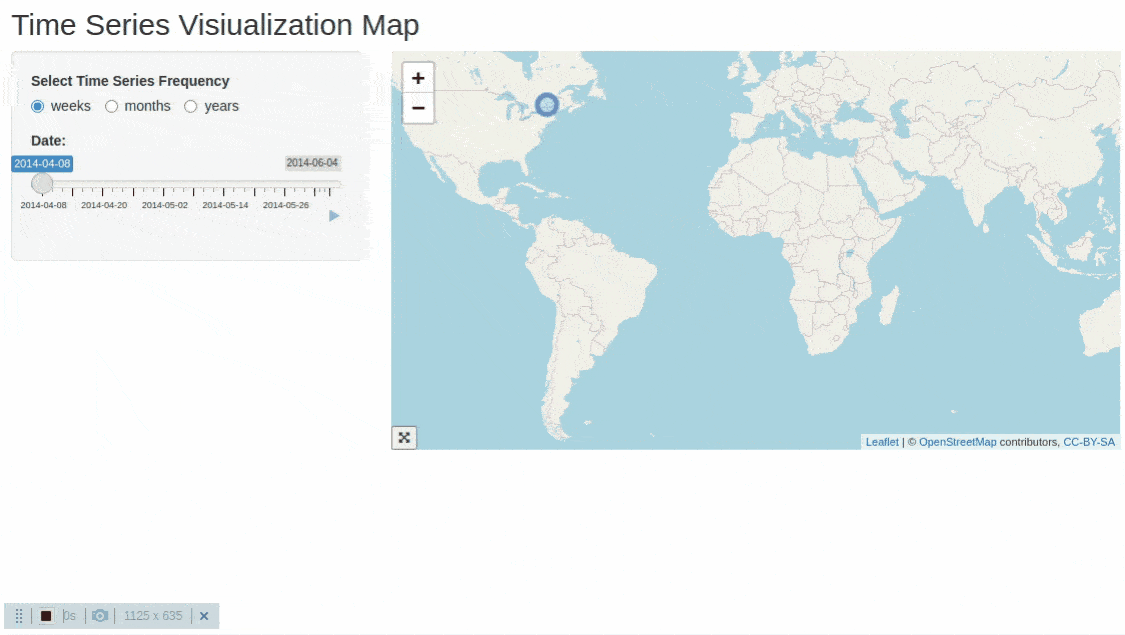单张全屏幕切换/按钮R发亮
单张全屏幕切换/按钮R发亮
提问于 2022-02-04 18:40:54
我正试图通过在time series中使用滑块通过leaflet创建一个R Shiny可视化。这个应用程序运行良好。作为另一个步骤,我正在尝试添加一个toggle/button,用户可以单击它,然后map将加载到fullscreen中。
如何添加按钮功能以切换全屏地图显示,然后再次单击它以返回到原始/默认大小?
代码
# This is a Shiny time series map web application
library(shiny)
library(tidyverse)
library(tidyr)
library(leaflet)
library(xts)
xts_to_tibble <- function(xts_obj) {
data.frame(index(xts_obj), coredata(xts_obj)) %>%
set_names(c("date", names(xts_obj))) %>%
as_tibble()
}
# Create sample data
Date <- c(
"2014-04-08", "2014-06-04", "2014-04-30",
"2014-05-30", "2014-05-01"
)
lat <- as.numeric(c(
"45.53814", "45.51076", "45.43560", "45.54332",
"45.52234"
))
lon <- as.numeric(c(
"-73.63672", "-73.61029", "-73.60100",
"-73.56000 ", "-73.59022"
))
id <- as.numeric(c("1", "2", "3", "4", "5"))
# Create a df from the above columns
df <- data.frame(id, lat, lon, Date)
df$Year <- lubridate::year(df$Date)
df$Month <- lubridate::month(df$Date, label = TRUE, abbr = FALSE)
df$Week <- lubridate::week(df$Date)
df$Date <- as.Date(df$Date)
ui <- fluidPage(
# Title
titlePanel("Time Series Visiualization Map"),
sidebarLayout(
# Define the sidebar
sidebarPanel(
radioButtons(
inputId = "Frequency",
label = " Select Time Series Frequency",
choices = c(
"weeks",
"months",
"years"
),
selected = "weeks",
inline = T
),
uiOutput("Time_Series_UI")
),
mainPanel(
leafletOutput("Time_Series_Map")
),
)
)
# Define server logic required to draw a histogram
server <- function(input, output) {
# Render slider input depending on data frequency
observe({
# Create an xts object
df_xts <- xts(df, order.by = as.Date(df$Date))
# All_Dates = unique(df$Start_Date)
Filtered_Dates <- df_xts[xts::endpoints(
df_xts,
on = input$Frequency
)] %>% xts_to_tibble()
output$Time_Series_UI <- renderUI({
sliderInput("Date", "Date:",
min = pull(slice_min(Filtered_Dates, date), date),
max = pull(slice_max(Filtered_Dates, date), date),
value = pull(slice_min(Filtered_Dates, date), date),
step = 1,
#timeFormat = "%YYYY-%MM-%DD",
animate = T
)
})
})
# Filter data for the date selected
Filtered_Data <- reactive({
req(input$Date)
filter(df, Date == input$Date)
})
# Create the leaflet map
output$Time_Series_Map <- renderLeaflet({
leaflet(df) %>%
addTiles() %>%
setView(lat = 0, lng = 0, zoom = 2)
})
# Create data markers for selected date
observe({
# print(input$Date)
leafletProxy("Time_Series_Map", data = Filtered_Data()) %>%
addCircleMarkers(
lng = ~lon, lat = ~lat,
popup = ~id
)
})
}
# Run the application
shinyApp(ui = ui, server = server)Stack Overflow用户
回答已采纳
发布于 2022-02-04 23:49:59
试试这段代码
# This is a Shiny time series map web application
library(shiny)
library(tidyverse)
library(leaflet)
library(xts)
xts_to_tibble <- function(xts_obj) {
data.frame(index(xts_obj), coredata(xts_obj)) %>%
set_names(c("date", names(xts_obj))) %>%
as_tibble()
}
# Create sample data
Date <- c(
"2014-04-08", "2014-06-04", "2014-04-30",
"2014-05-30", "2014-05-01"
)
lat <- as.numeric(c(
"45.53814", "45.51076", "45.43560", "45.54332",
"45.52234"
))
lon <- as.numeric(c(
"-73.63672", "-73.61029", "-73.60100",
"-73.56000 ", "-73.59022"
))
id <- as.numeric(c("1", "2", "3", "4", "5"))
# Create a df from the above columns
df <- data.frame(id, lat, lon, Date)
df$Year <- lubridate::year(df$Date)
df$Month <- lubridate::month(df$Date, label = TRUE, abbr = FALSE)
df$Week <- lubridate::week(df$Date)
df$Date <- as.Date(df$Date)
ui <- fluidPage(
htmltools::htmlDependencies(icon("", verify_fa = FALSE)),
tags$style(
'
.plot-zoom {
position: absolute;
border: none;
background-color: transparent;
bottom: 0;
left: 0;
z-index: 1;
}
.full-screen {
position: fixed;
height: 100vh !important;
width: 100vw !important;
left: 0;
top: 0;
z-index: 9999;
overflow: hidden;
}
.leaflet-full-screen {
position: relative;
}
'
),
# Title
titlePanel("Time Series Visiualization Map"),
sidebarLayout(
# Define the sidebar
sidebarPanel(
radioButtons(
inputId = "Frequency",
label = " Select Time Series Frequency",
choices = c(
"weeks",
"months",
"years"
),
selected = "weeks",
inline = T
),
uiOutput("Time_Series_UI")
),
mainPanel(
div(
class = "leaflet-full-screen",
leafletOutput("Time_Series_Map")
)
),
),
tags$script(HTML(
"
function plotZoom(el){
el = $(el);
var parent = el.parent().parent();
if(el.attr('data-full_screen') === 'false') {
parent.addClass('full-screen')
.css('position', '')
.trigger('resize').fadeOut().fadeIn();
el.attr('data-full_screen', 'true');
} else {
parent.removeClass('full-screen')
.css('position', 'relative')
.trigger('resize').fadeOut().fadeIn();
el.attr('data-full_screen', 'false');
}
}
$(function(){
$('.leaflet-full-screen .leaflet.html-widget').append(
`
<div class='plot-zoom'>
<button onclick=plotZoom(this) data-full_screen='false' title='Full screen'>
<i class='fa fa-expand-arrows-alt'></i>
</button>
</div>
`);
})
"
))
)
# Define server logic required to draw a histogram
server <- function(input, output) {
# Render slider input depending on data frequency
observe({
# Create an xts object
df_xts <- xts(df, order.by = as.Date(df$Date))
# All_Dates = unique(df$Start_Date)
Filtered_Dates <- df_xts[xts::endpoints(
df_xts,
on = input$Frequency
)] %>% xts_to_tibble()
output$Time_Series_UI <- renderUI({
sliderInput("Date", "Date:",
min = pull(slice_min(Filtered_Dates, date), date),
max = pull(slice_max(Filtered_Dates, date), date),
value = pull(slice_min(Filtered_Dates, date), date),
step = 1,
#timeFormat = "%YYYY-%MM-%DD",
animate = T
)
})
})
# Filter data for the date selected
Filtered_Data <- reactive({
req(input$Date)
filter(df, Date == input$Date)
})
# Create the leaflet map
output$Time_Series_Map <- renderLeaflet({
leaflet(df) %>%
addTiles() %>%
setView(lat = 0, lng = 0, zoom = 2)
})
# Create data markers for selected date
observe({
# print(input$Date)
leafletProxy("Time_Series_Map", data = Filtered_Data()) %>%
addCircleMarkers(
lng = ~lon, lat = ~lat,
popup = ~id
)
})
}
# Run the application
shinyApp(ui = ui, server = server)我在地图左下角加了一个小按钮。当点击它时,情节被放大到全屏,在全屏中,再次单击它将返回到正常视图。
如果你不喜欢按钮、位置或颜色等,你需要做的就是把你的情节组件放置在父母或祖父母或祖父母.父组件中,如果你不喜欢按钮、位置或颜色等,那就有class = "leaflet-full-screen".
- Change。
- 包含应用程序中的样式和脚本标签。通常,您希望将样式靠近应用程序的顶部(头部),并将脚本放在传单标签之后。
- 此功能适用于多个传单对象,因此它意味着它将将按钮添加到应用程序中的所有传单地图中。
看看我类似的答案,我们如何用plotly做同样的事情。不过,代码有点不同。

页面原文内容由Stack Overflow提供。腾讯云小微IT领域专用引擎提供翻译支持
原文链接:
https://stackoverflow.com/questions/70991329
复制相关文章
相似问题

